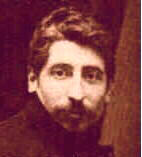Beginning in 1894, he exhibited at the
Salon National des Beaux-Arts. Among the works shown
there are : A young lady's head (Orsay Museum in Paris) the model of which is
Lydie, his brother Gaston's wife, and the Young
France, the model of which is his own wife,
placed at the top of a monumental fountain in Toul,
the Fontaine de Curel, the decoration and ornamentation
of which he also created. The studio he shared with his
brother in Paris, rue Dutot, 40, (presently rue du Dr
Roux), soon became a meeting place for a group of young
sculptors. These sought to break away from the
all-too-formal academies and to tend to a quieter and
more meditative sculpture with neater and simpler lines,
while still remaining respectful of traditional
values. |
Without doubt, these young sculptors all considered
Lucien Schnegg the leader of their "Bande
à Schnegg".
In 1898 Charles Saunier, an art critic, wrotes : "Messrs.
Lucien and Gaston Schnegg, twins in art, show some
spontaneous works of sculpture that seem to owe little to
scholarly studies."
On May 12-th 1898, the two brothers wrote to Rodin : "Facing
the hostility you met from the Société des Gens de
Lettres(1), we
consider it a duty to tell you of our wholehearted
admiration for your talent and especially for your statue
of Balzac." At the Universal Exhibition of
1900 in Paris, Lucien Schnegg won the gold medal for his
busts : in particular for a six month baby girl's bust,
a man's bust and an old man's study.
|
